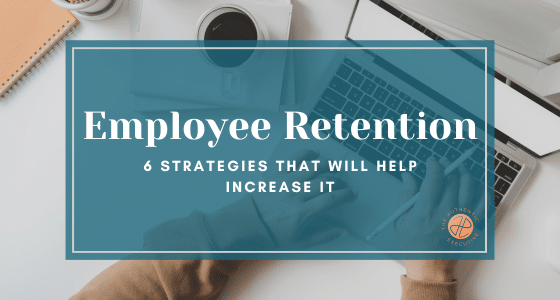Employee retention is at the top of the priority list for many organizations. In today’s climate, keeping your employees could be one of the most important parts of succeeding in your business. Not only will it reduce the costs of turnover, but it also has the potential to create a stable and high-performing workforce- when it’s done right! In this blog post, we’ll explore 6 Strategies To Help Increase Employee Retention and create a workplace where employees feel valued, engaged, and motivated to stay for the long haul.

6 Strategies To Help Increase Employee Retention
1. Ensure Your Managers Have Leadership Skills They Need
Developing strong leadership skills is essential for navigating the complexities of today’s professional landscape. Effective leaders cultivate a clear vision, inspire their teams, and communicate purposefully. They lead by example, demonstrating integrity, empathy, and resilience. Great leaders actively listen, encourage diverse perspectives, and empower their team members, fostering a culture of collaboration and innovation. Continuously honing skills in decision-making, problem-solving, and adaptability is crucial, as is nurturing emotional intelligence to understand and connect with others on a deeper level. Effective leadership isn’t about command but about enabling growth, both for individuals and the organization, while steering the team toward shared goals. By investing in leadership development, you create a ripple effect, driving excellence, and success at all levels of the organization.
2. Focus On Emotional Intelligence (EQ) in Leaders
Building emotional intelligence (EQ) in leaders is a transformative investment that drives exceptional leadership and organizational success. Leaders with high EQ possess the ability to understand and manage their own emotions while empathizing with and influencing the emotions of others. By fostering self-awareness, leaders become attuned to their strengths, weaknesses, and how their actions impact those around them. They excel in social awareness, recognizing the feelings and perspectives of their team members, leading to more effective communication, collaboration, and conflict resolution. Developing emotional intelligence equips leaders with invaluable skills, such as empathetic listening, recognizing nonverbal cues, and adapting their leadership style to the needs of the moment. This not only creates a positive and inclusive work culture but also enhances decision-making, resilience, and the ability to inspire and motivate their teams, resulting in a dynamic and thriving organization.
3. Cultivate a Culture of Personal Ownership
Cultivating a culture of personal ownership is the bedrock of a high-performing and resilient organization. When every team member takes ownership of their responsibilities, decisions, and actions, it creates a sense of accountability and commitment that drives results. Empower individuals to set goals, make informed choices, and drive their projects forward. Encourage a mindset of continuous improvement, where everyone identifies opportunities for growth and takes initiative to learn and adapt. Foster a culture where mistakes are seen as learning opportunities, and where feedback is constructive, enabling individuals to take ownership of their professional development. A culture of personal ownership not only leads to increased productivity but also boosts morale, innovation, and a collective sense of pride in the organization’s success, creating a vibrant and resilient work environment.
4. Be A Good Boss
Being a leader comes with great responsibility, and one crucial aspect is to avoid common behaviors that can undermine team morale, productivity, and overall success. When under stress, managers often revert to being directive rather than collaborative, assign tasks rather than delegate responsibilities, and are too busy to provide good feedback. Instead of inspiring, these behaviors create an atmosphere of fear and stress. Recognize and value the unique contributions of each team member, fostering a collaborative and inclusive environment. Respect work-life balance, provide constructive feedback, and be open to suggestions. A toxic-free workplace nurtures growth, creativity, and loyalty, ultimately leading to a thriving and harmonious team.
5. Offer Work Flexibility
Offering work flexibility is not just a perk; it’s a strategic move that empowers employees and enhances organizational success. By allowing flexible work arrangements such as remote work, flexible hours, or compressed workweeks, you acknowledge the diverse needs of your team, leading to increased job satisfaction and improved work-life balance. Flexibility fosters trust, autonomy, and a sense of responsibility, enabling employees to manage their tasks more efficiently. This approach not only attracts top talent but also boosts productivity and creativity by accommodating individual preferences and life circumstances. In the end, a workplace that prioritizes work flexibility reaps the benefits of a happier, more motivated, and loyal workforce, contributing to the growth and adaptability of the organization in an ever-changing landscape.
6. Genuinely Care About Your Employees
Genuinely caring about your employees isn’t just a soft gesture; it’s the cornerstone of a thriving and harmonious workplace. When you prioritize your team’s well-being, you create a positive environment that inspires loyalty, engagement, and high performance. Show empathy by understanding their personal and professional challenges, offer support, and provide opportunities for growth. Recognize and acknowledge their achievements, fostering a sense of belonging and motivation. Encourage open communication, actively listen, and act on their feedback. Invest in their development, promote work-life balance, and create a culture of respect and inclusivity. When you truly care about your employees, you not only build a strong team but also cultivate an environment where individuals can flourish, resulting in a powerful synergy that drives success for both the employees and the organization.
In conclusion, prioritizing employee retention is a strategic imperative that has far-reaching benefits for any organization.
By investing in creating a positive work environment, offering growth opportunities, recognizing achievements, and fostering open communication, businesses can retain valuable talent, reduce turnover costs, and maintain a consistent level of expertise within their teams. An engaged and committed workforce leads to improved productivity, enhanced customer satisfaction, and a more innovative and resilient organization. As the job market evolves and employees seek more than just a paycheck, focusing on employee retention is not just a competitive advantage; it’s a crucial component of sustainable success in the dynamic landscape of the modern workplace.





